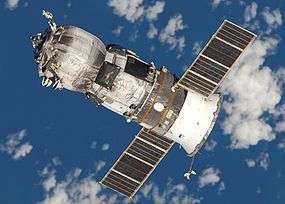Tianzhou (spacecraft)
.png) | |
| Country of origin | China |
|---|---|
| Operator | CNSA |
| Applications | Tiangong-2 resupply |
| Specifications | |
| Spacecraft type | Automated cargo spacecraft |
| Launch mass | Up to 13,500 kg (29,800 lb) |
| Payload capacity | Up to 6,500 kg (14,300 lb) |
| Dimensions | 9 m × 3.35 m (29.5 ft × 11.0 ft) |
| Volume | 15 m3 (530 cu ft) |
| Production | |
| Status | In Development |
| Related spacecraft | |
| Derived from | Tiangong-1 |
The Tianzhou (Chinese: 天舟; pinyin: Tiān Zhōu; literally: "Heavenly Ship") is a Chinese automated cargo spacecraft developed from the Tiangong-1 to resupply its future modular space station. It is expected to launch on the Long March 7 from Wenchang.[1] It is scheduled to make its inaugural flight in 2017 to demonstrate autonomous propellant transfer.[2]
Function
It will function as the main cargo transportation for the Chinese space station. It will have pressurized, semi-pressurized and unpressurized cargo capabilities. It shall be able to transport airtight cargo, large extravehicular payloads and experiment platforms. It is to be launched by a CZ-7 from the Hainan Space Launch Site.[2]
Name
The China Manned Space Engineering Office opened a consultation for the naming of the prospective cargo ship on April 25, 2011. By May 20, it had received more than 50,000 suggestions.[3] On July 8 Yang Liwei, China's first astronaut and deputy director of the Chinese Academy of Sciences revealed that they had a short list of ten names.[4] On October 31, 2013, it was revealed that they spacecraft had been named Tianzhou (Chinese: 天舟; pinyin: Tiān Zhōu; literally: "Heavenly Boat"), a portmanteau of the Chinese names of the Tiangong (Chinese: 天宫; pinyin: Tiān Gōng) space stations and the Shenzhou (Chinese: 神舟; pinyin: Shén Zhōu) spacecraft. They also stated that they would use the two letter identification TZ.[5]
Missions
| No. | Spacecraft | S/N | Launch (UTC) | Carrier Rocket |
Launch Pad |
Docking | Deorbit | Remarks | ||
|---|---|---|---|---|---|---|---|---|---|---|
| Station/ Port |
Docking | Undocking | ||||||||
| 1 | Tianzhou 1 | Unknown | 2017 | Long March 7 | Wenchang LC-2 | Tiangong-2 Fore | N/A | N/A | N/A | Maiden flight of the Tianzhou spacecraft. First Tianzhou flight to Tiangong-2. |
See also
- Comparison of space station cargo vehicles
- Progress spacecraft – an expendable cargo vehicle currently in use by the Russian Federal Space Agency
- Automated Transfer Vehicle – a retired expendable cargo vehicle used by the ESA
- Cygnus spacecraft – an expendable cargo vehicle developed by Orbital ATK under American CRS program, currently in use.
- H-II Transfer Vehicle – an expendable cargo vehicle currently in use by JAXA
- Dream Chaser Cargo System - a cargo variant of the reusable SNC's spaceplane
- Dragon cargo spacecraft - a reusable cargo vehicle developed by SpaceX, under American CRS program, currently in use.
References
- ↑ Barbosa, Rui C. (25 June 2016). "China successfully debuts Long March 7 rocket". NASASpaceflight.com.
- 1 2 Ping, Wu (June 2016). "China Manned Space Programme: Its Achievements and Future Developments" (PDF). China Manned Space Agency. Retrieved 2016-06-28.
- ↑ "中国货运飞船征名超5万个" [Chinese cargo ship over 50,000 new name] (in Chinese). China Network Television. 2011-05-20. Retrieved 2016-06-27.
- ↑ "中国货运飞船征名结束 龙舟等10个名字入选" [Chinese cargo ship sign name ends dragon boat 10 names selected] (in Chinese). 163.com. 2011-07-09. Retrieved 2016-06-27.
- ↑ "中国载人空间站命名"天宫"货运飞船为"天舟"" [China's manned space station cargo spacecraft to be named Tianzhou] (in Chinese). China News. 2013-10-31. Retrieved 2016-06-27.

